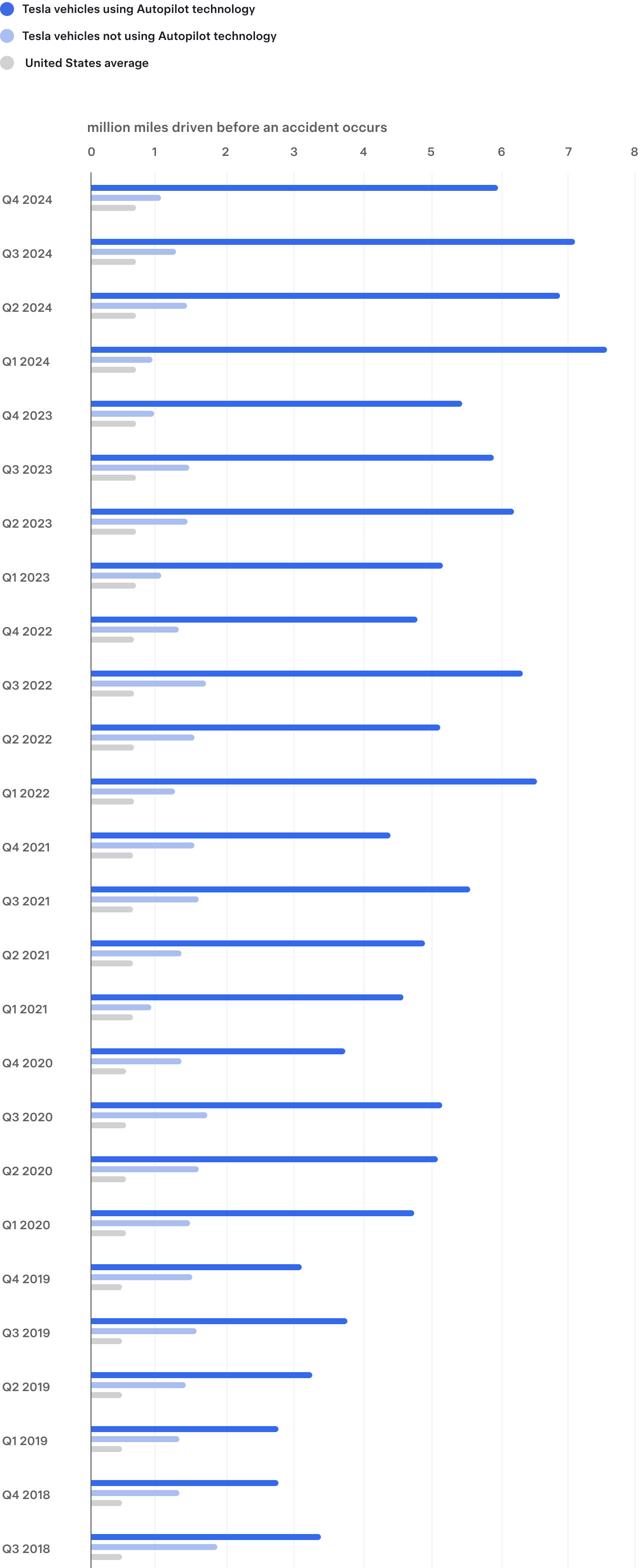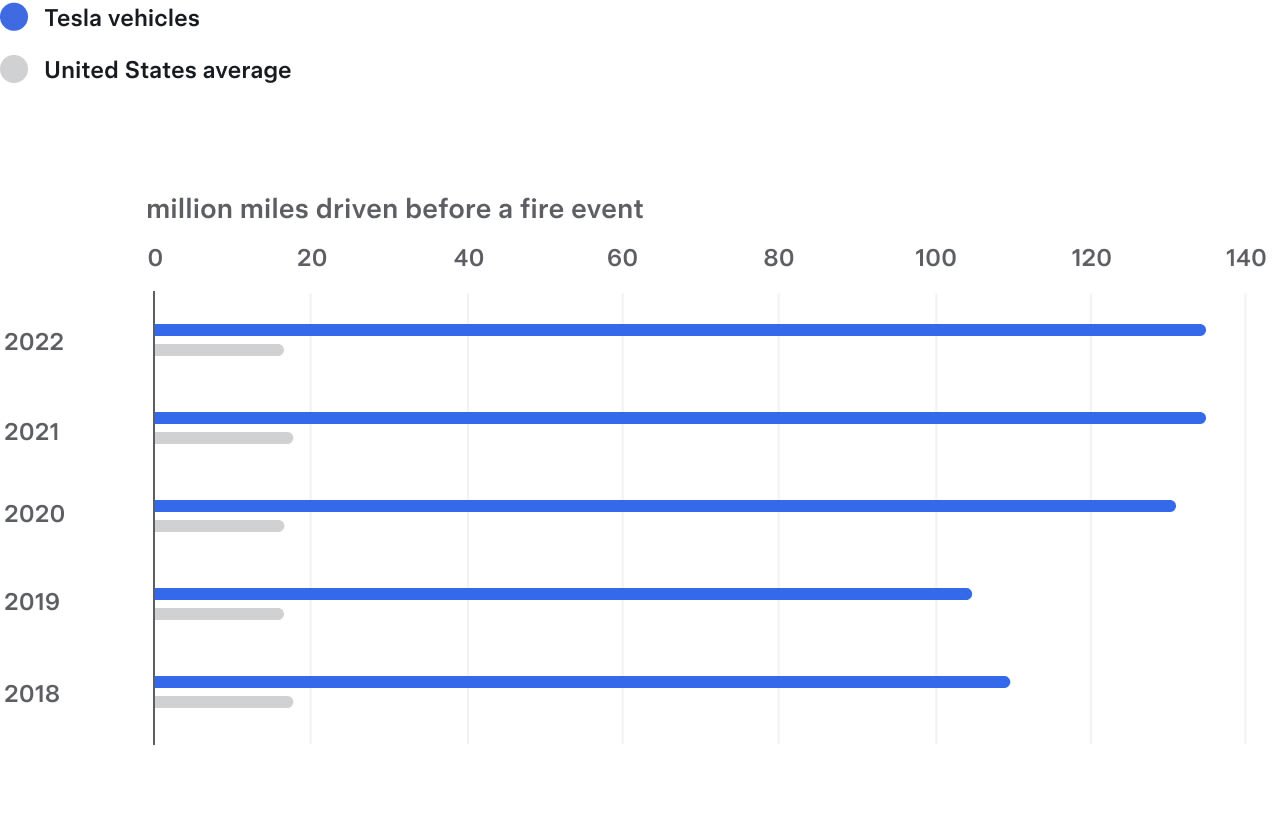Tesla Vehicle Safety Report
At Tesla, we believe that technology can help improve safety. That’s why Tesla vehicles are engineered to be the safest cars in the world. We believe the unique combination of passive safety, active safety, and automated driver assistance is crucial for keeping not just Tesla drivers and passengers safe, but all drivers on the road. It’s this notion that grounds every decision we make – from the design of our cars, to the software we introduce, to the features we offer every Tesla owner.
Model S, Model 3, Model X and Model Y have achieved among the lowest overall probability of injury of any vehicles ever tested by the U.S. government’s New Car Assessment Program. Much of this has to do with the rigid, fortified structure of the battery pack that is mounted to the car’s floor, which provides a vehicle with exceptional strength, large crumple zones, and a uniquely low center of gravity. Because of their strength, Tesla’s battery packs rarely incur serious damage in accidents. And, in the extremely unlikely event that a fire occurs, the state-of-the-art design of our battery packs ensures that its safety system works as intended and isolates a fire to select areas within the battery while simultaneously venting heat away from the passenger cabin and the vehicle.
While no car can prevent all accidents, we work every day to try to make them much less likely to occur. Active safety features come standard on all Tesla vehicles made after September 2014 for an added layer of safety beyond the physical structure of each car. Because every Tesla is connected, we’re able to use the billions of miles of real-world data from our global fleet – of which more than 9 billion have been driven with Autopilot engaged – to understand the different ways accidents happen. We then develop features that can help Tesla drivers mitigate or avoid accidents. Through over-the-air software updates, we’re able to introduce safety features and enhancements long after a car has been delivered, as well as release updated versions of existing safety features that take into account the most up-to-date real-world data collected by our fleet.
In October 2018, we began voluntarily releasing quarterly safety data in order to provide critical safety information about our vehicles to the public, and in July 2019 we began voluntarily releasing annually updated data about vehicle fires as well. Accident rates among all vehicles on the road can vary from quarter to quarter and can be affected by seasonality, like reduced daylight and inclement weather conditions.
Miles Driven Per One Accident

Vehicle Fire Data

Tesla is committed to collecting, analyzing, and reporting the most accurate data available regarding vehicle and fire safety. To that end, we continuously refine our methodology, detection processes and algorithms for the collection and analysis of fire event reports involving Tesla vehicles, including events where the evidence indicates the fire did not originate with the vehicle. We learn about fire events from a wide variety of internal and external sources, such as available vehicle telemetry, customer service, and media reports. For this reason, we may not be notified of a fire event until months after it occurs. Therefore, to better reflect what we have learned about fire events involving Tesla vehicles, we now collect annual vehicle fire data for a year before publishing to capture all known events. This approach is also consistent with how the National Fire Protection Association (NFPA) reports on vehicle fire events.
Our global data indicates that, between 2012 and 2022, approximately one Tesla vehicle fire event occurred for every 130 million vehicle miles traveled. By comparison, data from the NFPA and U.S. Department of Transportation indicate that one vehicle fire occurs in the United States for every 18 million miles traveled. Compared to average vehicles on the road, Tesla vehicles are comparatively even less likely to be involved in a fire event than these numbers suggest, because Tesla's data includes fire events that are caused by structure fires, wildfires, arson, and other causes unrelated to the vehicle, whereas the NFPA data excludes any fires where a structure is involved.
In addition, because Tesla is committed to reporting the most accurate and comprehensive data possible, we also provide yearly averages over the past 5 years, as illustrated above. These numbers reflect known fire events that occur globally in each calendar year, and they are normalized by vehicle fleet mileage that accrued during that year.
Methodology:
We collect the amount of miles traveled by each vehicle with Autopilot active or in manual driving, based on available data we receive from the fleet, and do so without identifying specific vehicles to protect privacy. We also receive a crash alert anytime a crash is reported to us from the fleet, which may include data about whether Autopilot was active at the time of impact. To ensure our statistics are conservative, we count any crash in which Autopilot was deactivated within 5 seconds before impact, and we count all crashes in which the incident alert indicated an airbag or other active restraint deployed. (Our crash statistics are not based on sample data sets or estimates.) In practice, this correlates to nearly any crash at about 12 mph (20 kph) or above, depending on the crash forces generated. We do not differentiate based on the type of crash or fault (For example, more than 35% of all Autopilot crashes occur when the Tesla vehicle is rear-ended by another vehicle). In this way, we are confident that the statistics we share unquestionably show the benefits of Autopilot.
Please note that seasonality can affect crash rates from quarter to quarter, particularly in quarters where reduced daylight and inclement or wintry weather conditions are more common. To minimize seasonality as a variable, compare a quarter to the same quarter in prior years.
*Update (January 2023):
We are proud of Autopilot’s performance and its impact on reducing traffic collisions. The benefit and promise of Autopilot is clear from the Vehicle Safety Report data that we have been sharing for 4 years. As part of Tesla’s commitment to continuous improvement, recent analysis led us to identify and implement upgrades to our data reporting. Specifically, we discovered reports of certain events where no airbag or other active restraint deployed, single events that were counted more than once, and reports of invalid or duplicated mileage records. Including these events is inconsistent with our methodology for the Vehicle Safety Report and they will be excluded going forward. These upgrades in data analysis reinforce the positive impact that Autopilot has on vehicle safety. To ensure the accuracy of our reporting, we updated all collision rates historically to account for these upgrades, including the baseline collision rates for the United States based on currently available NHTSA and FHWA data. (Note that for purposes of the baseline collision rates in the United States, an automobile crash is one that involves at least one passenger vehicle, light truck, SUV or van that is 10,000 pounds or less, as classified by available federal data.) The end result is that, when Autopilot is active, the collision rates are even lower than we previously reported.